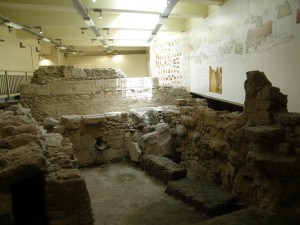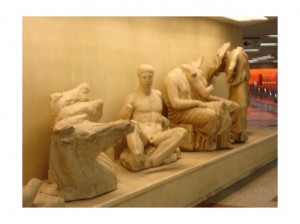The Athens metro is the most beautiful metro we’ve ever seen. It is clean and it runs smoothly which makes it easy to like, but the true gems are built into the metro as mini-museums that take you back thousands of years.
The metro has one line which dates back to the late 1800s. Two other lines were added when the metro went through major renovations in the 1990s and, if I’m not mistaken, this renovation was partially inspired to bolster their 1996 Summer Olympics bid. Though the attempt proved futile, the metro is absolutely striking. The renovation ended around 2000 and was quite the expenditure which some Greeks say contributed to their current economic state.
 Work on the metro was slow because of all the antiquities discovered along the way. The main problem construction workers faced was not having to dig through rock but having to sift through history. Every time they dug a new hole they would find an ancient grave or a wall or road so they would put down their picks and shovels and call in the archaeologists who would do their digging with toothbrushes. This time was well worth it, however, because this metro is no typical transportation network, it is a series of mini exhibitions.
Work on the metro was slow because of all the antiquities discovered along the way. The main problem construction workers faced was not having to dig through rock but having to sift through history. Every time they dug a new hole they would find an ancient grave or a wall or road so they would put down their picks and shovels and call in the archaeologists who would do their digging with toothbrushes. This time was well worth it, however, because this metro is no typical transportation network, it is a series of mini exhibitions.
 Walking down marble steps into the station, you find yourself in a modern universe with ticket machines and escalators. But as you descend to a track, you pass all sorts of artifacts from different periods of Athenian civilization. Encased in glass is stratified excavation where you see ancient pots, oil lamps, mosaic floors, columns, portions of walls and roads, cisterns, burial remains, clay drainage pipes, and more. These artifacts range from the 6th century BC through Byzantine times. There are also plaster casts of figures from the Parthenon.
Walking down marble steps into the station, you find yourself in a modern universe with ticket machines and escalators. But as you descend to a track, you pass all sorts of artifacts from different periods of Athenian civilization. Encased in glass is stratified excavation where you see ancient pots, oil lamps, mosaic floors, columns, portions of walls and roads, cisterns, burial remains, clay drainage pipes, and more. These artifacts range from the 6th century BC through Byzantine times. There are also plaster casts of figures from the Parthenon.
 On top of being cultural and educational, the metro is untarnished which is a feat for any public transportation unit. The cars themselves are clean and operate smoothly. The stations are spacious and well-lit with hardly a mark of graffito or piece of garbage to be seen. Most platforms even have a monitor which indicates when the next metro is arriving.
On top of being cultural and educational, the metro is untarnished which is a feat for any public transportation unit. The cars themselves are clean and operate smoothly. The stations are spacious and well-lit with hardly a mark of graffito or piece of garbage to be seen. Most platforms even have a monitor which indicates when the next metro is arriving.
 The only unfortunate aspect of all this free and especially available history is the fact that it is overlooked due to the inevitable quick pace demanded by its milieu. People generally treat public transport as a means to an end and therefore wouldn’t stop to look at a vase.
The only unfortunate aspect of all this free and especially available history is the fact that it is overlooked due to the inevitable quick pace demanded by its milieu. People generally treat public transport as a means to an end and therefore wouldn’t stop to look at a vase.
 However, I’ve been pleasantly surprised by the number of people who do stop and think about artifacts. Quite a few people do gaze at the 2,500 year-old ceramic vase, more properly called amphora, which was once given to the winner of the Panathenaic games. Many appreciate the fact this vase was once filled with first-class olive oil—a precious and expensive delicacy. And that this olive oil was a prize for one of four sports festivals held in ancient Greece collectively called the Panhellenic games. And that one of the other three sports festivals held every four years in Olympia is still celebrated. Very soon in fact, in London. All of this history is contained in one vase, in one mini-museum of one metro station. Fortunately for us, we pass through these stations daily and take it in as we scurry through.
However, I’ve been pleasantly surprised by the number of people who do stop and think about artifacts. Quite a few people do gaze at the 2,500 year-old ceramic vase, more properly called amphora, which was once given to the winner of the Panathenaic games. Many appreciate the fact this vase was once filled with first-class olive oil—a precious and expensive delicacy. And that this olive oil was a prize for one of four sports festivals held in ancient Greece collectively called the Panhellenic games. And that one of the other three sports festivals held every four years in Olympia is still celebrated. Very soon in fact, in London. All of this history is contained in one vase, in one mini-museum of one metro station. Fortunately for us, we pass through these stations daily and take it in as we scurry through.
In Athens, history truly is everywhere to be found. Even underground.
